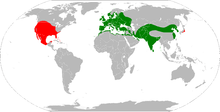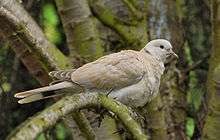Eurasian collared dove
| Eurasian collared dove | |
|---|---|
 | |
| Streptopelia decaocto
Call | |
| Scientific classification | |
| Kingdom: | Animalia |
| Phylum: | Chordata |
| Class: | Aves |
| Order: | Columbiformes |
| Family: | Columbidae |
| Genus: | Streptopelia |
| Species: | S. decaocto |
| Binomial name | |
| Streptopelia decaocto (Frivaldszky, 1838) | |
 | |
The Eurasian collared dove (Streptopelia decaocto), most often simply called the collared dove,[2][3][4][5] also sometimes hyphenated as Eurasian collared-dove,[6] is a species of dove native to warm temperate and subtropical Asia, and introduced in North America in 1980s.
Description

It is a medium-sized dove, distinctly smaller than the wood pigeon, similar in length to a rock pigeon but slimmer and longer-tailed, and slightly larger than the related turtle dove, with an average length of 32 cm (13 in)[7] from tip of beak to tip of tail, with a wingspan of 47–55 cm (19–22 in), and a weight of 125–240 g (4.4–8.5 oz). It is grey-buff to pinkish-grey overall, a little darker above than below, with a blue-grey under wing patch. The tail feathers are grey-buff above, and dark grey tipped white below; the outer tail feathers also tipped whitish above. It has a black half-collar edged with white on its nape from which it gets its name. The short legs are red and the bill is black. The iris is red, but from a distance the eyes appear to be black, as the pupil is relatively large and only a narrow rim of reddish-brown iris can be seen around the black pupil. The eye is surrounded by a small area of bare skin, which is either white or yellow. The two sexes are virtually indistinguishable; juveniles differ in having a poorly developed collar, and a brown iris.[2][4][5]
It is closely related to the island collared dove of southeast Asia and the African collared dove of sub-Saharan Africa, forming a superspecies with these.[6] Identification from African collared dove is very difficult with silent birds, with the African species being marginally smaller and paler, but the calls are very distinct, a soft purring in African collared dove quite unlike the Eurasian collared dove's cooing.[2]
Distribution


The collared dove is not migratory, but is strongly dispersive. Over the last century, it has been one of the great colonisers of the bird world. Its original range at the end of the 19th century was warm temperate and subtropical Asia from Turkey east to southern China and south through India to Sri Lanka. In 1838 it was reported in Bulgaria, but not until the 20th century did it expand across Europe, appearing in parts of the Balkans between 1900–1920, and then spreading rapidly northwest, reaching Germany in 1945, Great Britain by 1953 (breeding for the first time in 1956), Ireland in 1959, and the Faroe Islands in the early 1970s. Subsequent spread was 'sideways' from this fast northwest spread, reaching northeast to north of the Arctic Circle in Norway and east to the Ural Mountains in Russia, and southwest to the Canary Islands and northern Africa from Morocco to Egypt, by the end of the 20th century. In the east of its range, it has also spread northeast to most of central and northern China, and locally (probably introduced) in Japan.[2][3][4][6] It has also reached Iceland as a vagrant (41 records up to 2006), but has not colonised successfully there.[8]
There are two subspecies, Streptopelia decaocto decaocto in most of the range (including all of the 20th century colonisations), and Streptopelia decaocto xanthocyclus in the southeast of the range from Burma east to southern China. The latter differs in having yellow skin around the eye (white in the nominate subspecies).[6] Two other subspecies formerly sometimes accepted, Streptopelia decaocto stoliczkae from Turkestan in central Asia, and Streptopelia decaocto intercedens from southern India and Sri Lanka,[4] are now considered synonyms of S. d. decaocto.[6]
Invasive species
The collared dove was introduced into the Bahamas in the 1970s and spread from there to Florida by 1982. It has become invasive;[9] the stronghold in North America is still the Gulf Coast, but it is now found as far south as Puerto Escondido and Tehuantepec in Oaxaca, as far west as California, and as far north as Alaska, Alberta, the Great Lakes, and Nova Scotia. Their relatively early presence in the Cancún area may suggest they arrived there overwater. Some of the more distantly dispersed records may refer to local escapes from captivity.[6] Its impact on other species there is as yet unknown; it appears to occupy an ecological niche between that of the mourning dove and the rock pigeon (also an invasive species in North America). In Arkansas (United States), the species was recorded first in 1989 and since then has grown in numbers and is now present in 42 of 75 counties in the state. It spread from the southeast corner of the state in 1997 to the northwest corner in 5 years, covering a distance of about 500 km (310 mi) at a rate of 100 km (62 mi) per year.[10] This is more than double the rate of 45 km (28 mi) per year observed in Europe.[11]
Behaviour

.jpg)
Collared doves typically breed close to human habitation wherever food resources are abundant and there are trees for nesting; almost all nests are within 1 km (0.62 mi) of inhabited buildings. The female lays two white eggs in a stick nest, which she incubates during the night and which the male incubates during the day. Incubation lasts between 14 and 18 days, with the young fledging after 15 to 19 days. Breeding occurs throughout the year when abundant food is available, though only rarely in winter in areas with cold winters such as northeastern Europe. Three to four broods per year is common, although up to six broods in a year has been recorded.[4]
The male's mating display is a ritual flight, which, as many other pigeons, consists of a rapid, near-vertical climb to height followed by a long glide downward in a circle, with the wings held below the body in an inverted "V" shape. At all other times, flight is typically direct using fast and clipped wing beats and without use of gliding.
The collared dove is not wary and often feeds very close to human habitation, including visiting bird tables; the largest populations are typically found around farms where spilt grain is frequent around grain stores or where livestock are fed. It is a gregarious species and sizeable winter flocks will form where there are food supplies such as grain (its main food) as well as seeds, shoots and insects. Flocks most commonly number between ten and fifty, but flocks of up to ten thousand have been recorded.[4]
The song is a coo-COO-coo, repeated many times. It is phonetically similar to the Greek decaocto ("eighteen"), to which the bird owes its zoological name. It also makes a harsh loud screeching call lasting about two seconds, particularly in flight just before landing. A rough way to describe the screeching sound is a hah-hah.
Collared doves cooing in early spring are sometimes mistakenly reported as the calls of early-arriving cuckoos and, as such, a mistaken sign of spring's return.[4]
They are almost always seen in pairs and, like many birds, remain loyal to their mates.
References
- ↑ BirdLife International (2012). "Streptopelia decaocto". IUCN Red List of Threatened Species. Version 2013.2. International Union for Conservation of Nature. Retrieved 26 November 2013.
- 1 2 3 4 Snow, D. W.; Perrins, C. M. (1998). The Birds of the Western Palearctic (Concise ed.). Oxford: Oxford University Press. ISBN 0-19-854099-X.
- 1 2 Hagemeijer, W. J. M., & Blair, M. J., eds. (1997). The EBCC Atlas of European Breeding Birds. Poyser, London ISBN 0-85661-091-7.
- 1 2 3 4 5 6 7 Cramp, S., ed. (1985). The Birds of the Western Palearctic 4: 340-353. ISBN 978-0-19-857507-8
- 1 2 Javier Blasco-Zumeta, Laboratorio Virtual Ibercaja Collared Dove
- 1 2 3 4 5 6 Hoyo, J. del, et al., eds. (1997). Handbook of the Birds of the World, vol. 4. Barcelona: Lynx Edicions. p. 137. ISBN 84-87334-22-9.
- ↑ Campbell, Donald (2000). "Collared Dove". The Encyclopedia of British Birds. Bath: Parragon. p. 95. ISBN 0752541595.
- ↑ Birding Iceland: Eurasian Collared Dove
- ↑ Beckett, S. M., Komar, N., & Doherty, P. F. (2007). Population Estimates for Eurasian Collared-dove in Northeastern Colorado. The Wilson Journal of Ornithology 119 (3): 471-475. Abstract.
- ↑ Fielder, J. M., R. Kannan, D. A. James, and J. C. Cunningham (2012). Status, dispersal, and breeding biology of the exotic Eurasian Collared-dove (Streptopelia decaocto) in Arkansas. J. Arkansas Academy of Science 66: 55-61.
- ↑ Hengeveld, R. (1988). Mechanisms of biological invasions. J. of Biogeography 15:819-828.
External links
| Wikimedia Commons has media related to Eurasian Collared Dove. |
| Wikispecies has information related to: Streptopelia decaocto |
- Ageing and sexing (PDF; 4.6 MB) by Javier Blasco-Zumeta & Gerd-Michael Heinze
- Eurasian Collared-dove videos, photos, and sounds at the Internet Bird Collection
- Eurasian Collared-dove photo gallery at VIREO (Drexel University)
- Interactive range map of Streptopelia decaocto at IUCN Red List maps
